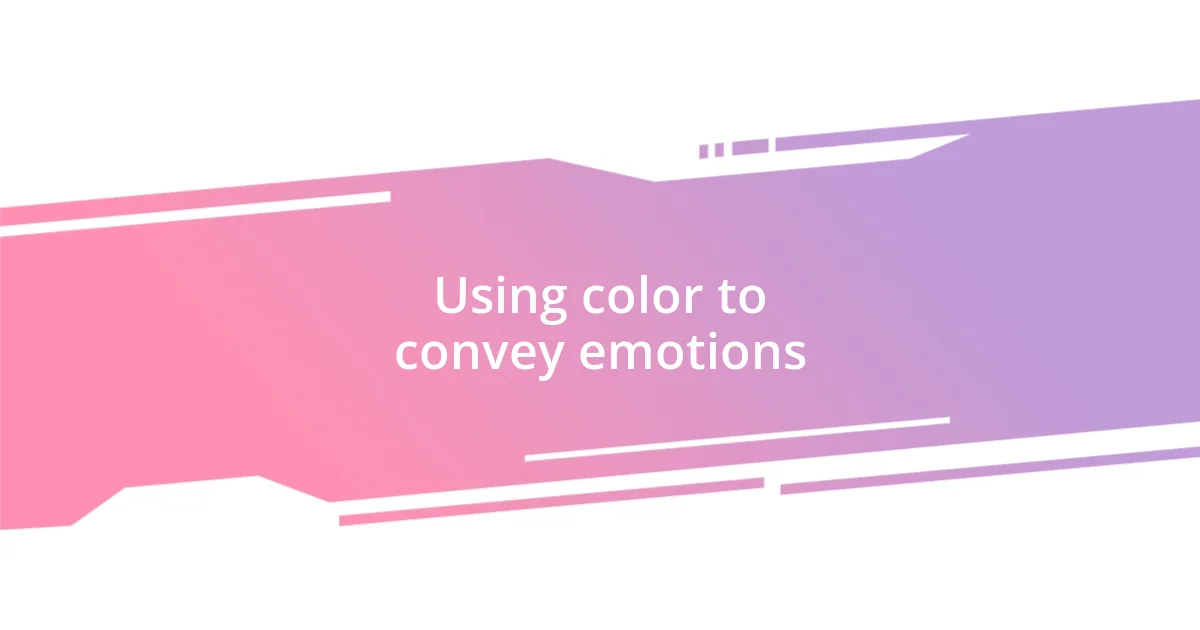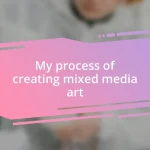Key takeaways:
- Understanding color theory enhances emotional expression in art by utilizing different color palettes and combinations, influencing the mood and viewer’s experience.
- Techniques like wet-on-wet blending, dry brushing, and glazing can elevate artwork by creating depth, texture, and emotional resonance through color application.
- Experimentation with color, including contrasting and unexpected hues, fosters creativity and can lead to rich, dynamic visual storytelling in artistic compositions.

Understanding color theory
Color theory is like a secret language that artists use to communicate emotions and ideas through their work. I remember the first time I learned about complementary colors—those hues sitting opposite each other on the color wheel. It was a revelation! The way they enhanced each other in my paintings brought a vibrancy I hadn’t experienced before, making me wonder: how can something so simple transform my art so profoundly?
As I delved deeper, I discovered the emotional impact of colors. For instance, I’ve always found blue to evoke feelings of calm and tranquility, while red often stirs up passion and energy. A few years back, while working on a piece about heartbreak, I intuitively reached for cooler shades, allowing the colors to mirror my emotional state. It’s fascinating to consider how colors can connect us to our feelings and memories, isn’t it?
Understanding color theory has also helped me experiment with different palettes. For instance, using analogous colors—those that sit next to each other on the color wheel—creates a sense of harmony in my artwork. When I wanted to portray a serene landscape, I leaned into greens and yellows, which felt natural and soothing. Have you found yourself drawn to particular color combinations that resonate with your own experiences?

Choosing the right color palette
Choosing the right color palette can transform an ordinary piece into something extraordinary. I often begin by considering the mood I want to evoke. For example, when I painted a sunset recently, I instinctively reached for warm oranges and soft pinks. The warmth in those colors not only captured the essence of the moment but also invited viewers to feel the same tranquility I experienced that evening.
Another strategy I employ is to study the themes of my artwork. If I am portraying nature, earthy tones like browns and greens help ground the piece and create a sense of place. I remember a time when I created a forest scene with layers of deep greens and rich browns; the color choices seemed to wrap the viewer in the embrace of the woods. It’s amazing how certain colors can make one feel rooted or uplifted, isn’t it?
Finally, I often play around with limited palettes. When I explored monochromatic themes in a series, using varying shades of blue, the results surprised me. Each piece felt cohesive and allowed the nuances of form and texture to come to the forefront. Discovering and refining my palette has been a journey that continuously shapes my artistic expression.
| Color Effect | Usage |
|---|---|
| Warm Colors | Create energy and warmth; ideal for passionate themes. |
| Cool Colors | Evoke calmness; great for serene scenes. |
| Analogous Palette | Develop harmony; perfect for natural landscapes. |
| Monochromatic Palette | Focuses on texture and tone; emphasizes cohesiveness. |

Using color to convey emotions
Using color to convey emotions is something that deeply resonates with me as an artist. I remember the day I experimented with shades of green when painting a piece reflecting the joy of spring. The vibrant greens felt alive—invigorating and fresh. My brush danced across the canvas, and with each stroke, I could almost feel the warmth of the sun and the promise of new beginnings. It’s incredible how a mere color choice can transport not only me but also the viewers to a specific emotional landscape.
I’ve also found that the context in which colors are used matters greatly. For instance, during a particularly challenging period in my life, I created a series using somber grays and muted browns. I aimed to express feelings of isolation and struggle. Each color felt heavy, almost like a weight upon my shoulders. Yet, the act of painting it became a cathartic release, allowing me to process those emotions and, in turn, connect with others who experienced similar feelings. Here are some insights on utilizing color for emotional expression:
- Warm Colors: Infuse passion and vibrancy, ideal for artwork celebrating joy or excitement.
- Cool Colors: Use blues and greens to evoke tranquility and peace, perfect for serene themes.
- Contrasting Colors: Juxtapose different shades to create tension and highlight emotional conflict, enhancing storytelling.
- Desaturated Colors: Employ muted palettes to reflect sadness or nostalgia, drawing viewers into deeper feelings.

Techniques for blending colors
Blending colors is more than just a technical skill; it’s a true dance between hues that transforms a canvas into a symphony. One method I find particularly effective is the wet-on-wet technique. When I paint, I often layer my colors while the canvas is still wet, allowing the pigments to seamlessly merge. It feels almost as if I’m inviting the colors to mingle, creating soft transitions and dreamy effects. Have you ever tried this? There’s something magical about watching colors flow into one another spontaneously.
Another technique I’ve embraced is dry brushing. This involves using a stiff brush with little paint to create a textured finish. I remember working on a rocky landscape where I wanted the roughness of the rocks to shine through. By lightly sweeping my brush across the canvas, I achieved a sense of depth and dimension. It’s fascinating how a simple adjustment in pressure can dramatically change the outcome. Have you noticed how texture can add a whole new layer to your color choices?
Finally, I can’t forget the power of glazing. This technique involves applying thin, transparent layers of color over dry paint. I often use glazing to give depth to shadows or enhance highlights. I once layered a translucent gold over a sunset scene, and the effect was stunning—it made the entire painting glow. The beauty lies in discovering how a subtle tweak can elevate the emotional tone of the artwork. Have you ever experienced a moment where a single technique transformed your piece?

Creating contrast with color
Creating contrast with color is an art in itself, and I love how it can transform a piece. I recall a vibrant landscape I painted where I used a fiery red sunset against a backdrop of deep blues and purples. The stark contrast made the scene come alive, almost as if the sky was pulsating with energy. Have you ever noticed how contrasting colors can pull you into the moment, creating an emotional stir?
Sometimes, I choose complementary colors to create that eye-catching juxtaposition. For instance, in a recent portrait, I boldly paired an emerald green dress against a rich magenta background. This approach not only highlighted the subject but also conveyed a sense of vibrancy and drama. I find that using contrast in this way invites the viewer to engage with the artwork more deeply—don’t you feel that too?
Experimentation has taught me the importance of using contrast to evoke specific feelings. One time, I painted a serene lake at dawn, using a soft pastel palette for the water but then incorporating sharp, bold strokes of orange in the reflections. This unexpected twist created a tension that stirred feelings of hope and renewal. It’s fascinating how a few calculated choices can alter the emotional narrative of a piece. What effects have you noticed when you experiment with contrast in your own art?

Incorporating color in composition
Incorporating color into my composition is essential for setting the mood of my artwork. One technique I’ve embraced is using color harmony to create a balanced visual experience. For instance, when I painted a serene forest scene, I relied heavily on shades of green and brown. I remember stepping back and feeling an overwhelming sense of calm wash over me—it’s like the colors invited the viewer into a peaceful retreat. Have you ever felt a similar connection with the colors in your work?
Another aspect I pay close attention to is color temperature. Using warm colors, like oranges and yellows, can bring an uplifting feeling, much like the warmth of sunlight streaming through a window. During a project focused on capturing a summer day, I used these vibrant hues to convey joy and energy. It amazed me how just a few well-placed warm tones could evoke such a cheerful atmosphere. Have you tried experimenting with warmth and coolness in your pieces?
I often find myself considering the emotional implications of my color choices within the composition. During one painting, I decided to depict a stormy sky using dark grays and blues, counterbalanced by the vibrant oranges of lightning striking through. That contrast created a dramatic tension that drew viewers in. It reminded me that color can serve as a storyteller; it can guide feelings and perceptions. How do you think your color choices narrate your artistic story?

Experimenting with color in practice
Experimenting with color in my practice often feels like embarking on a delightful adventure. Recently, I played with a monochromatic palette, exploring various shades of blue in a seascape. The subtle variations communicated different moods—ranging from tranquil calmness to a powerful storm. Did you know how much emotion a single color can convey through its numerous tones?
One of my favorite experiments involved layering translucent glazes of color in a floral piece. By mixing warm pinks and cool purples, I created depth and softness that truly brought the flowers to life. I was surprised by how the light caught the different layers, giving the painting an ethereal glow. Have you ever tried layering colors to see how they interact with each other on the canvas?
I also enjoy incorporating unexpected colors into my pieces, as it can lead to fascinating results. For instance, while painting a winter landscape, I decided to add unexpected splashes of bright yellow and pink. Initially, I hesitated, wondering if it would feel out of place, but the final result was a striking balance that felt alive and hopeful. Isn’t it intriguing how breaking the rules can inspire creativity?














